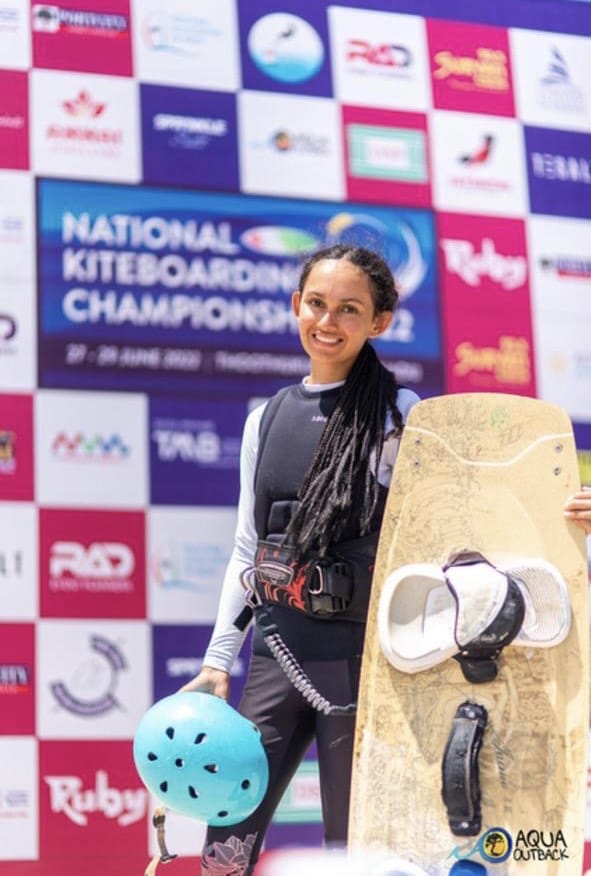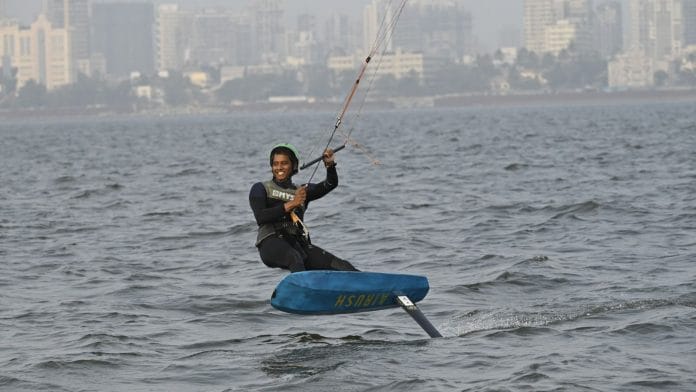When he’s bouncing and bobbing over the waves holding on to a mammoth kite, 21-year-old Chitresh Tatha forgets that once he had the fear of water. Today, he’s got a new goal—Paris. For the first time, kiteboarding or kitesurfing will make a debut at the Olympic Games 2024 and Tatha wants a spot in the Indian team.
Much like any other sport, it takes years of experience and prep to qualify at the Olympic level, but Tatha’s journey challenges these conventions. Before he became a national-level sailor at the age of 12, and now kite surfer, he had a terrible case of aquaphobia.
“I wouldn’t even go to the beach, it was my worst nightmare,” says Tatha. The Chennai athlete overcame his fears and has been training for a little over a year as a professional kitesurfer, which is a very short time going by the sports’ standard.
The niche water sport—where athletes are propelled across the surface of the sea by a giant kite that harnesses the power of the wind—has a small but growing following in India. And kitesurfers, especially recreational thrill seekers, are looking to their own backyards to learn and train in the sport. They chase the wind in hotspots like Rameshwaram, Kanyakumari, Odisha, Tuticorin and Goa.
“Ninety-five per cent of people that try kitesurfing do it as a hobby and learn from someone who is certified by the International Kiteboarding Organisation,” says Dylan Fernandes, a national kitesurfer champion and instructor. The other aspect is racing, the more competitive sport which very few Indian kitesurfers participate in.
The International Olympic Committee has recognised ‘Formula Kite’, a class of kitesurfing that requires an athlete to know how to ‘foil’ the board when it is attached with a hydrofoil. With this, a rider can coast above the water instead of on the water. A foil board requires far less wind power to go out and about the waves as it faces less resistance from the water.
But according to Fernandes, there are few Indian coaches to train athletes at an international level. Many are still in the process of securing certifications to reach that level of training formula kiters.
Tatha has turned to coaches abroad. With the help of his mentor from Thailand, Fawn Benyapa, a 2021 Master World Champion herself, and kitesurfing coach, Daniel Leow from Malaysia, he’s ready to tackle the Asian Games this year, placing him one step closer to the big Olympic dream.
Also read: Books-to-OTT business takes off in India—The Story Ink team reads, reads and adapts
Nursing a dream between Thailand and Chennai
Tatha’s foray into kiting began during the second year of his B.Com degree at D.G. Vaishnav College, but he was not new to the world of competitive sports. At 12, he became the youngest Indian athlete to take part in the sailing competition in the Optimus Dinghy Category at the Asian Games in 2014. But it wasn’t enough. As a teenager, he wanted to experiment more with sailing. It was also a way to tackle his fear of water.
Online classes during the Covid-induced lockdown gave him more time to explore kitesurfing until he decided that this was something he wanted to pursue full time.
Today, he trains five hours a day, six days a week on the sandy coastlines of Thailand. He shuttles between Thailand and Chennai every three-four weeks, either training on the beach with Leow and Benyapa, or waiting for visa approval to head back for training to Thailand.
Tatha has developed a sense of bonhomie with other aspiring kitesurfers in Thailand who are hoping to qualify for the Paris Olympics. They train together at the gym about three times a week and motivate each other.
“We are very far behind the European athletes, so we push each other. It helps me set a standard, and where I want to see myself at the end of the month,” says Tatha, who attended his first Formula Kite competition, which also happened to be the trials for the Asian Games, in Abu Dhabi last year.
With experienced pros from Hong Kong, Taiwan and the UAE competing by his side on the waves, Tatha struggled to finish the races. He was the only Indian kitesurfer competing in the race.
But Tatha calls it fate. With the Asian Games getting postponed to September 2023 owing to the Covid-19 pandemic, as well as the trials getting pushed to January and February this year, Tatha was gifted with time, to give it another shot.
And that he did. Chitresh fought tooth and nail at the trials that took place at Mumbai’s Girgaon Chowpatty. He victoriously laid claim to one of the coveted 20 spots that confirms one’s seat at the Asian Games.
For the Olympics, there are separate categories for both men and women in Formula Kite. And only one person from each category can represent the country on the world stage. If Chitresh gets through the Asian Games and World Championships in the Netherlands in August 2023, then his Olympic dream will become a reality.
Also read: Pulwama widows’ fight in Rajasthan has exposed an age-old secret—chura pratha exploitation
India is fertile but not without challenges
Kitesurfing gear doesn’t come cheap and is not manufactured in India. A twin tip board demands an investment of Rs 2-3 lakh but this is not accepted by the IOC, which specifies a foil kite and board. A foil board alone can cost approximately Rs 15 lakh.
The irony is that India’s coastlines are perfect for the sport, says Arjun Motha, a national level kitesurfer and founder of Aqua Outback Tuticorin, one of the leading kitesurfing schools in the country.
“For at least 8 to 10 months a year there’s good wind to practise.” The gap between India and Sri Lanka where wind passes through creates a “funnel effect” that accounts for these ideal windy conditions.
“My college friends are interested but it’s the cost that holds them back. To reach Level 3 in kitesurfing—where you get certified as an independent kitesurfer— might come to roughly Rs 50,000 for classes and courses,” says professional kite surfer Keona Rajani (19).

She isn’t eyeing Paris 2024 just yet, but the former windsurfer has been bagging medals in the women’s kitesurfing category since she took up the sport two years ago in Goa. She brought home a gold at the Indian National Kiteboarding Championship in Goa (2022) as well as a silver medal in the Kiteboarding Nationals Tournament in Tuticorin (2022).
Taking inspiration from her father who is also a kitesurfer, the Goa-based athlete has been chasing the wind and waves in Morjim and Mandrem Beach under the mentorship of Phillipe Dartnell who runs the oldest and first kitesurfing school in India.
Owing to its wind dependency and seasonality, Keona, who is doing her BA in psychology at St. Xavier’s College, Mapusa, makes the most of the windy days in Goa to train. Her goal is to become a licenced instructor before her undergraduate programme ends, and master the art of foiling.
Both Tatha and Rajani purchase second hand gear. According to them, the kitesurfing community, small as it may be, is passionate, encouraging and connects them to people that bring gear from overseas as well as surfers that offer to sell their old gear at lower prices.
“In India, only those who can afford it can think of taking it up. There are people who haven’t even heard of the sport, but if you look at France or China, there’s more awareness and with that comes more availability of equipment, and even used equipment that you can borrow.” says Tatha.
The 21-year-old has no sponsors, and costs for gear, training as well entry fees and accommodation into the biggest championships across the globe, are personal expenses his family incurs. It can run into lakhs.
He intends to attend the World Sailing Championships in the Netherlands in August this year, the entry fee alone is Rs 51,000. Many of his friends are already in professional colleges or charting out more stable and secure jobs.
“I have accepted the fact that I will be late in life when it comes to getting a job. I know that I will be behind my friends but I won’t regret this decision. I try to do whatever I can at this age, because I know I can’t do it when I am older,” says Tatha.
(Edited by Anurag Chaubey)






